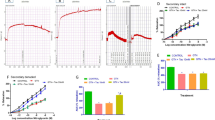Abstract
Recently, we have reported that a new synthetic compound, 1,2bis(nicotinamido)-propane (nicaraven), improved cardiac function following preservation and reperfusion. In this study, we investigated the efficacy of nicaraven as a radical scavenger by using an in vitro model of oxidative stress, to clarify mechanisms of the protective effect of this new compound on reperfusion injury in rat heart. Ring segments of epicardial right coronary arteries (RCA) of pig were suspended in organ chambers and exposed to hydroxyl radicals (·OH), generated (by two different systems ) by 0.28 mM FeSO4/0.28 mM H2O2 and DHF/Fe3+-ADP (2.4 mM, 43 nM, and 1.56 uM, respectively) to the bathing solution for 60 min. Prior exposure of the coronary arteries to ·OH significantly produced right-ward shift of the dose-response curves of the bradykinin-induced endothelium-dependent relaxations (an increase in the ED50 value for bradykinin by 4.37 and 1.98 times than control in two different ·OH generating systems, respectively), but did not affect the maximum relaxation responses. The presence of nicaraven (10-4 and 10-5 M) in the ·OH generating system, shifted the dose-response curves to bradykinin to the control level, suggesting a significant hydroxyl radical scavenging effect of the drug. These results indicate that nicaraven, a new hydroxyl radical scavenger, exhibits a protective effect on hydroxyl radicalinduced endothelial dysfunctions of pig coronary artery.
Similar content being viewed by others
References
Pearson PJ, Schaff HV, Vanhoutte PM: Acute impairment of endothelium-dependent relaxations to aggregating platelets following reperfusion injury in canine coronary arteries. Circ Res 67: 385–393, 1990
Pearson PJ, Schaff HV, Vanhoutte PM: Long-term impairment of endothelium-dependent relaxations to aggregating platelets following reperfusion injury in canine coronary arteries. Circulation 81: 1921–1927, 1990
Metha JL, Nichols WW, Donnely WH, Lawson DL, Saldeen TGP: Impaired canine coronary vasodilator response to acetylcholine and bradykinin after occlusion-reperfusion. Circulation 64: 43–54, 1989
William RE, Zweier JL, Flaherty JT: Treatment with deferoxamine during ischemia improves functional and metabolic recovery and reduces reperfusion-induced oxygen radical generation in rabbit hearts. Circulation 83: 1006–1014,1991
Ambrosio G, Zweier JL, Jacobus WE, Weisfeldt ML, Flaherty JT: Improvement of postischemic myocardial function and metabolism induced by administration of deferoxamine at the time of reflow: the role of iron in the pathogenesis of reperfusion injury. Circulation 76: 906–15, 1987
Ambrosio G, Flaherty JT: Effects of the Superoxide Radical Scavenger Superoxide Dismutase, and of the Hydroxyl Radical Scavenger Mannitol, on reperfusion Injury in Isolated rabbit Hearts. Cardiovasc Drugs Ther 6: 623–632, 1992
Asano T, Sasaki T, Koide T, Takakura K, Sano K: Experimental evaluation of the beneficial effect of an antioxidant on cerebral vasospasm. Neurol Res 6: 49–53, 1984
Asano T, Joshita H, Koide T, Takakura K: Amelioration of ischemic cerebral oedema by a free radical scavenger, AVS:1,2-bis(nicotinamido)-propane. An experimental study using a regional ischemia model in cats. Neurol Res 6: 163–168, 1984
Asano T, Sano K, Takakura K, Kikuchi H, Nagai H, Saito I, Tamura A, Ochiai C, Sasaki T: Effects of a hydroxyl radical scavenger on delayed ischaemic neurological deficits following aneurysmal subarachnoid haemorrhage: results of multicenter, placebocontrolled double-blind trial. J Neurosurg 84: 792–8()3,1996
Ohta S, Nishihara J, Oka Y, Todo H, Kumon Y, Sasaki S: Possible mechanism to induce protein kinase C-dependent arterial smooth muscle contraction after subarachnoid haemorrhage. Acta Neurochirurgica 137: 217–225, 1995
Ku K, Kin S, Hashimoto M, Saitoh Y, Nosaka S, Iwasaki S, Alam MS, Nakayama K: Role of a hydroxyl radical scavenger (Nicaraven) in recovery of cardiac function following preservation and reperfusion. Transplantation 62: 1090–1095, 1996
Hashimoto M, Lisa AC, Ishida Y, Paul RJ: Dependence of endotheliummediated relaxation on oxygen and metabolism in porcine coronary arteries. Am J Physiol 265: H299–H306, 1993
Hashimoto K, Pearson PJ, Schaff VH, Cartier R: Endothelial cell dysfunction after ischemic arrest and reperfusion: A possible mechanism of myocardial injury during reflow. J Thorac Cardiovasc Surg 102: 688–694, 1991
Lefer AM, Tsao PS, Lefer DJ, Ma XL: Role of endothelial dysfunction in the pathogenesis of reperfusion injury after myocardial ischemia. FASEB J 5: 2029–2034, 1991
Jarasch ED, Bruder G, Heid HW: Significance of xanthine oxidase in capillary endothelial cells. Acta Physiol Scand (Suppl) 548: 39–46, 1986
Guarnieri C, Flamigni F, Caldarera CM: Role of oxygen in the cellular damage induced by re-oxygenation of hypoxic heart. J Mol Cell Cardiol 12: 797–808, 1980
Myers CL, Weiss SJ, Kirsh MM, Shlafer M: Involvement of hydrogen peroxide and hydroxyl radical in the ‘oxygen paradox’: Reduction of creatine kinase by catalase, allopurinol or deferoxamine, but not by the superoxide dismutase. J Mol Cell Cardiol 17: 675–684, 1985
Zweier JL, Kuppusamy P, Lutty GA: Measurement of endothelial cell free radical generation: evidence for a central mechanism of free radical injury in postischemic tissues. Proc Natl Acad Sci USA 85: 4046–4050, 1988
Mankad PS, Chester AH, Yacoub MH: Role of potassium concentration in cardioplegic solutions in mediating endothelial damage. Ann Thorac Surg 51: 89–93, 1991
Todoki K, Okabe E, Kiyose T, Sekishita T, Ito H: Oxygen free radicalmediated selective endothelial dysfunction in isolated coronary artery. Am J Physiol 262: H806–812, 1992
Koide T, Noda Y, Asano T, Matsushita H: Lipid peroxidation and cerebral vasospasm. A beneficial pharmacological approach by AVS (a radical scavenger). Proc 11th Symposium, Drugs and Actions, Sendai Japan, 1983, pp 121–125
Grover AK, Samson SE: Protection of Ca pump of coronary artery against inactivation by superoxide radical. Am J Physiol 256: C666–673, 1989
Suzuki YJ, Ford GD: Inhibition of the Ca2+-ATPase of vascular smooth muscle sarcoplasmic reticulum by reactive oxygen intermediates. Am J Physiol 261: H568–H574, 1991
Sasaki H, Okabe E: Modification by hydroxyl radicals of functional reactivity in rabbit lingual artery. Jpn J Pharmacol 62: 305–314, 1993
Author information
Authors and Affiliations
Rights and permissions
About this article
Cite this article
Shah Alam, M., Ku, K., Yamauchi, M. et al. Protective effects of nicaraven, a new hydroxyl radical scavenger, on the endothelial dysfunction after exposure of pig coronary artery to hydroxyl radicals. Mol Cell Biochem 178, 237–243 (1998). https://doi.org/10.1023/A:1006855917392
Issue Date:
DOI: https://doi.org/10.1023/A:1006855917392




